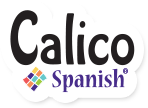Two keys to successful homeschool co-op Spanish
I am the curriculum specialist in charge of developing Stories here at Calico Spanish, but I am also a mom to three young kids. For the last few years, we participated in a homeschool co-op that met once a week. At the co-op, I taught Spanish. For my younger age group (K-4th grade), I used the Calico Spanish Stories program. As I’ve taught the program, I’ve identified two strategies that have helped set us up for success with Stories in a homeschool co-op.

Co-op Key 1: Streamline the lesson plans.
Time for a few background details. Stories features four levels:
- Level A: “I Am Special”
- Level B: “I Love My Family”
- Level C: “I Live Here”
- Level D: “Welcome to the Farm”
– Follow us on Twitter –
Within each level, we have developed eight units. Each unit is based on one animated video story and learners explore the story’s language through ten regular lesson plans. Additional review days and Culture Capsules mean that there are close to 100 lesson plans, more or less, in each level.
Hold on. I see my little co-op learners once a week for around 45 minutes, for total of 32 weeks a year. How are we supposed to get through a hundred lesson plans?
The answer is to collapse the lesson plans into a streamlined version that fits my homeschool co-op schedule. We move through a level at about 3 weeks per Unit. That means we do between 3 and 4 lesson plans per meeting. With an occasional review week and an occasional Culture Capsule week, that puts us on a good pace to finish one level per year.
– Like Calico Spanish on Facebook –
What does it mean to teach “3 lesson plans per meeting?” If you look at the lesson plans, you’ll see that children are asked to watch the Video Story in each lesson, sometimes twice, or once plus one viewing of the Dialogue Video. So when I say we move through 3 lesson plans, I don’t mean that we follow the plans exactly and end up watching the Video Story five times. Rather, I look at the content for three days and streamline it into the one time that I have. For example, we may:
1) Start with a song.
2) Ask each other our name and/or how we’re doing and/or what our ages are.
3) Watch the Video Story.
4) Sing a song or try another dialogue.
5) Watch the Video Story or a segment of the Video Story looking for a specific term (e.g. children wave every time they hear “hola” or “adiós,” hold up something blue every time they hear “azul”).
6) Play a quick round of I Spy.
7) Do the first activity sheet for the Unit (which I may need to adapt for preliterate learners).
With my young learners, we finished Levels A and B in about a school year each. With your learners, though, depending on what they are able to accomplish at home, you may well move faster than that. This also depends on what they already know, and may change in Levels B, C, and D, where the lesson plans require a little more time.
– Follow us on Instagram too! –
Introduce a child you love to a lifelong journey of speaking real Spanish to real people. Click the red button to experience it FREE.
Co-op Key 2: Use home time strategically.
With only one meeting per week, especially if that meeting is for less than 90 minutes, you actually won’t see language gains among your learners at all unless you leverage home time. That’s according to the American Council on the Teaching of Foreign Languages (ACTFL). Plus, good scaffolding (supporting complex tasks with baby-step practice) will set them up for more success and more communication in those class times you do have.
Here are some examples of what your learners could do at home:
- Watch the song video every day. (These are all on our YouTube channel.)
- Use the Activity Sheet to tell parents/siblings what they did in class.
- Ask each family to purchase the Storybook set for the level and read them together at home.
- Watch a related video. I recommend Peppa Pig and Pocoyó, with Spanish-language episodes freely available on YouTube.
Of course, families who want their children to have access to the full program for more review at home (e.g. with the digital flash cards) are welcome to purchase a login for their home use as well.
Remember most of all: 1) Expose children to as much comprehensible Spanish as possible in your class time and at home, and 2) have fun on the journey!
Sara-Elizabeth Cottrell is a homeschool mom of three bilingual children. She’s also a Spanish teacher and the Chief Storyteller for Calico Spanish.






No Comments